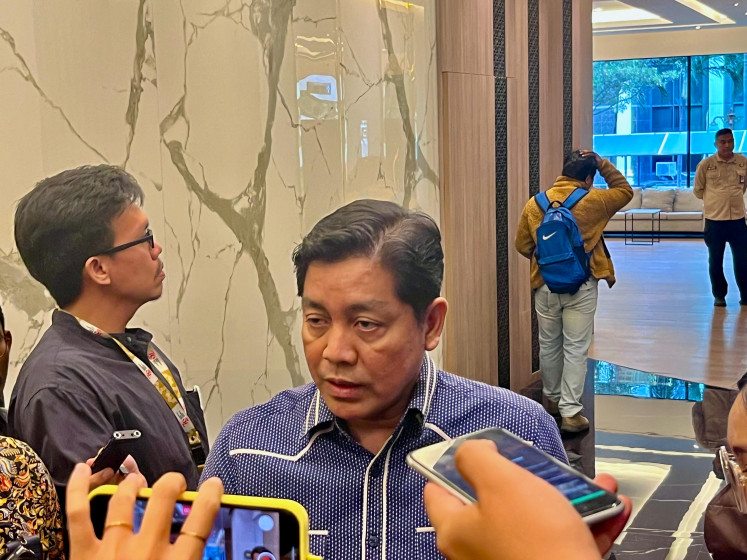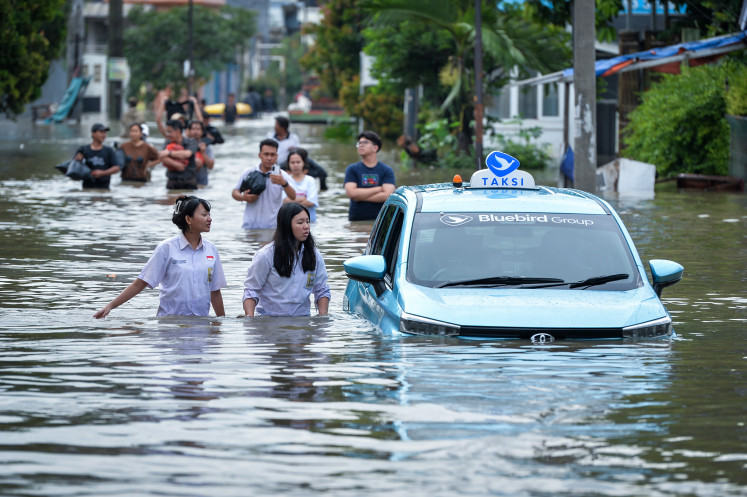Popular Reads
Top Results
Can't find what you're looking for?
View all search resultsPopular Reads
Top Results
Can't find what you're looking for?
View all search resultsBalinese: Between decline and transformation
Am I prejudiced? This is the question I asked myself a few days ago while arguing with noted Balinese scholar Nyoman Darma Putra
Change text size
Gift Premium Articles
to Anyone
Am I prejudiced? This is the question I asked myself a few days ago while arguing with noted Balinese scholar Nyoman Darma Putra.
Guardians of culture: Sekeha Kidung, a group of men or women assigned to recite and sing sacred verses and literary texts during religious ceremonies, plays an important part in preserving Balinese in the modern era. JP/I Wayan Juniartha
I had missed the launch of his new book: Tonggak Baru Sastra Bali Modern (New Facts about Modern Balinese Literature), but I now found myself, two days later, sitting with him at the Pomodoro Italian restaurant in Northern Denpasar and discussing this very same book.
In fact, I had accepted his invitation only because I wanted confirmation of a “hunch”, which I deemed a certainty: I was sure the Balinese language is under threat.
Hasn’t UNESCO announced the probable extinctions of hundred of languages in the coming century? Isn’t it also true too that Balinese is now rarely spoken in Denpasar?
But, after listening to Darma Putra’s arguments, I started to wonder: What if we were both wrong? What if I was yet another “victim” of the West’s obsession with “Decline and Fall” that has haunted many Westerners, from Titus Livus down to Gibbon and Rousseau?
According to Darma Putra — and he gave good arguments that I present below — Balinese culture and language are not in decline. They are “transforming” themselves. Interesting! I was almost convinced.
With one reservation, though: if I am an inveterate Rousseauist, what if Darmaputra were reading Balinese reality through the prism of his own, very “Balinese”, Hindu cyclical dynamism? So, are we, he as much as I, trapped in our respective, deep-seated cultural patterns and prejudices?
And if so, is it possible to be objective?
Darma Putra’s book is an interesting description of the long decline, and now renaissance, of Balinese literature and language. A collection of articles published in various media, it begins with history, showing that modern Balinese literature appeared well before what was thought until recently, when Wayan Gobiah published his novel Nemu Karma in 1931.
He recently discovered that the first truly “modern” writer in Balinese was Guru Pasek, who published short stories 100 years ago.
Darma Putra then shows that literature in Balinese was at best surviving until twenty years ago, as if the thrust of “Malay-Indonesian”, associated first with the notion of progress and then with nationalism, were so strong as to threaten the long-term survival of Balinese.
Magazines in Balinese emerged to then disappear after a few months or years, their most reputed writers, Made Sanggra, Nyoman Manda and Djelantik Santha, never becoming more than “marginal” figures in an intellectual and literary life — dominated by Indonesian. This went along with the fact that Balinese language was not taught beyond primary education and, outside rituals, never used in official occasions, including to teach or discuss Balinese literature at the academic level.
More attention was in fact paid to the dead Kawi language than to modern Balinese. There was of course a political background to this predicament.
The New Order regime, militaristic in nature, emphasized “unity” rather than “diversity” — the two concepts found in the national motto of Unity in Diversity (Bhinneka Tunggal Ika).
Modern languages other than the national language (Indonesian) were implicitly deemed potential threats.
A few pasamuhan (seminars) were held, and even regulations on the use of Balinese enacted (1992), but this was mere lip service to the notion of “diversity”. Thus, lacking genuine political support, and with works read at best by a few hundred people, Balinese literature only survived, at best.
Furthermore, most of the works published were poetry or short stories. Hardly any essays were published. All this had dramatic consequences: Balinese lost its ability to create words adapted to modern realities. It failed in particular to grasp abstraction.
As a result, it turned into a lingo mixing Balinese grammatical structures with an increasingly Indonesian-laden vocabulary.
Yet, Darma Putra demonstrates in his book, through literary examples, and otherwise explains verbally, that the situation above is now changing.
The swing is now going the other way, he says emphatically, as the result of a complex mix of social and political factors.
Indeed, the changes associated to tourism, and the fact in particular that the Balinese people are losing control over their own economy, was bound to provoke reactions beyond the lip service mentioned above.
Exogenous factors also played a role. The Balinese were not the only ones to wish to react against the centralistic cultural policies of the New Order.
In 1989, a Sundanese writer from West-Java, Ayip Rosidi, set up an association that delivered a prize — Hadiah Rancage — to writers in Sundanese. This prize was later extended to Javanese writers in 1994 and to Balinese in 1998.
Meanwhile, pressure started building up for the respect of “diversity” (kebhinnekaan). Seminar speakers, such as Ngurah Bagus in Bali, became more vocal.
The climax, though, was the fall of the military government in 1998, which transformed the balance of power between the center (Jakarta) and regions. A law establishing local autonomy was rapidly passed, which gave locals much broader control over the cultural policy of their respective regions.
This reversed the “decline” trend: Balinese became part of the secondary education curriculum. A Balinese television channel was launched. Last but not least, in 2006, the Bali Post started publishing a weekly addendum to its Sunday edition.
All this created a new momentum. Students are now enrolling in droves in Balinese language departments. Some have become writers.
They now write in the Bali Orti section of the Bali Post.
This revival upsurge impacts the language itself, which is becoming more “modern”. The use of the levels of language — with their inherent display of status inequality — is becoming more supple; and a Balinese abstract vocabulary dealing with modern issues is now appearing.
This clearly shows that “evolution” is a complex matter when it comes to language and societies.
Political swings, themselves the result of people’s awareness, play a prominent role in the matter. A fact already demonstrated in the revival of Hebrew and, more recently, of Ukrainian, not to mention Gaelic and Breton.
But let’s remain aware that decline might well still be lurking in the corner: Why is it that fewer and fewer of my friends are addressing me in Balinese?
So, is Balinese becoming provisionally entrenched in some sectors of society while it is disappearing from others — urban life, interethnic communication, in which Indonesian and English are taking over?
And more importantly: if Balinese is turning into a vehicle of modernity, is it still able to transmit the island’s cultural memory? Every Balinese now knows Batman and Mickey Mouse. But what about Pan Balang Tamak, Sutasoma and Gagak Aking? There may be no decline of the language, but a decadence of culture.
On the whole, if Westerners have to temper their “gloom and doom” tendencies, so should Balinese with their overly optimistic “transformationism”.










